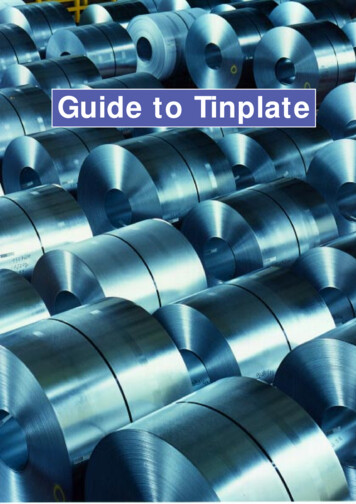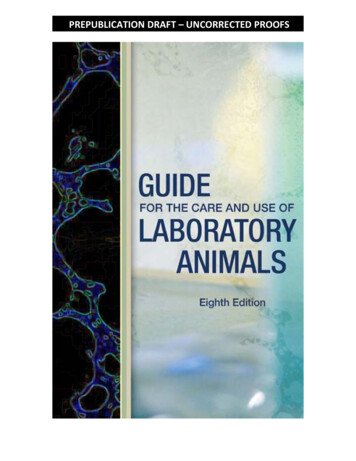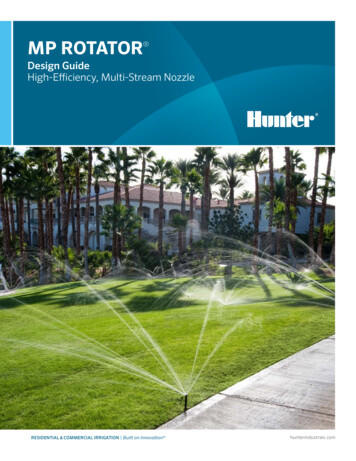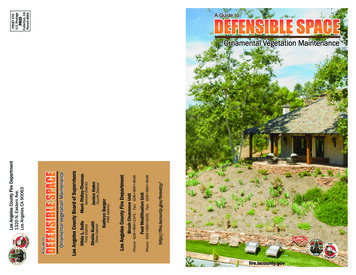
Transcription
Guide to Tinplate138
ITRI LtdITRI Ltd is the world’s foremost authority on tin and its applications and isrecognised by the UK government as a Scientific Research Organisation. ITRI issponsored by the world-wide tin industry, both miners and smelters, to supportand expand the use of tin metal, through continuous improvement of thetechnological processes involved in its applications, the development of newuses and promotion through conferences, seminars etc. ITRI research is ongoingin the following main areas:Tinplate packagingTin alloy coatingsSolder technologyChemical applicationsEnvironmentally driven projects133
Providingexpertisein tintechnologyandapplicationsITRA is a membership based organisation providingcontact research, testing, analytical andinformation services to the tin industry.For more informtion contact Dr Steve BlundenITRA Ltd. Kingston Lane, Uxbridge, Middlesex UB8 3PJTel: 44 1895 272 406 Fax: 44 1895 251 841 www.itri.co.uk137
ITRA Ltd (Tinplate Panel)ITRA Ltd is a membership-based organisation, established in 1993, to servicethe needs of the tin consuming industries. Member companies have access tothe services and expertise of ITRI, as well as the results of its chemical andmetallurgical R & D programmes. In addition, Industry Group Panels devoted toeither tinplate packaging, chemical applications or solder technology (Soldertec),provide a forum for discussion and collaboration.The ITRA Tinplate Panel aims to help the tinplate industry maintain and developits market share through technical support and collaboration, and represents allsegments of the tinplate packaging industry (tinplate producers, electrolytesuppliers, can makers, lacquer manufacturers etc), throughout all regions of theworld. Collaborative programmes cover such topics as:Lacquer performanceCorrosion resistanceCan decoration / product differentiationEnvironmental issuesFull details of membership of the ITRA Ltd Tinplate Panel may be obtainedfrom:ITRA Ltd (Tinplate Panel)Kingston LaneUxbridgeMiddlesexUB8 3PJUKTel: 44 (0) 1895 272406Fax: 44 (0) 1895 251841Copyright 2000 ITRA Ltd.Printed in the UKPublished by ITRA Ltd.,Kingston Lane, Uxbridge, Middlesex, UB8 3PJ, United Kingdom.134
ACKNOWLEDGEMENTSThis 2nd Edition of the Guide to Tinplate was prepared using contributions writtenby technical experts from companies and organisations involved in the tinplatepackaging industry, all of whom are members of the ITRA Ltd, Tinplate Panel.The following are therefore gratefully acknowledged:Corus (UK & Netherlands)Crown Cork & Seal (UK)ICI Packaging Coatings (UK)Lawson Mardon Can (UK)National Steel (USA)PPG Packaging Coatings (UK)Rasselstein Hoesch (Germany)Shipley Ronal (USA)Usinor (Belgium)VAI Industries (UK) LtdThe Association of European Producers of Steel for Packaging (APEAL), Belgiumare also thanked and in particular Mr. Bev Page (Consultant) is thanked for hiscontributions and editorial review.135
Acknowledgements to FiguresFigures 2, 4, 5, 7, 9, VAI (UK) Ltd.Figures 3, 6, Rasselstein Hoesch GmbH.Figure 8, Blaw-Knox Co., Aetna-Standard Div.Figure 10, The Head Wrightson Machine Co. Ltd.Figure 11, “From The Making, Shaping and Treating of Steel, Association ofIron Steel Engineers, with permission”.Figure 17, 18, Continental Can European Industries SA.Figures, 19, 20, 22, Crown Cork & Seal Company, Inc.Figure 21, Krupp Kunststofftechnik GmbH.Figures 23, 24, 25, The Association of European Producers of Steel for Packaging(APEAL).Cover photograph by kind permission ofRasselstein Hoesch GmbH136
INTRODUCTIONTinplate is light gauge, cold-reduced low-carbon steel sheet or strip, coated onboth faces with commercially pure tin. It thus combines in one material thestrength and formability of steel and the corrosion resistance, solderability andgood appearance of tin. Within this broad description, there exists today anextremely wide range of products, tailor-made to meet particular end-userequirements. Production of the steel base and its subsequent coating with tinare independent of each other, so that any set of properties in the steel, can intheory be combined with any tin coating. The composition of the steel used fortinplate is closely controlled and according to the grade chosen and its mannerof processing, various types with different formabilities (“tempers”) can beproduced. Tinplate is sold in a range of steel thicknesses, from around 0.5 mmto 0.13 mm. The steel can be coated with differing thicknesses of tin, and evendifferent thicknesses on the two faces (differential coatings) may be producedto cater for varying conditions at the internal and external surfaces of a container.A variety of surface finishes are also produced for diverse applications. Tinplatehas a special passivation treatment to stabilise the surface and improve adhesionof lacquers; it also carries a very thin film of an oil to improve its handling andfabrication properties. This oil is, of course, compatible with food products.The resulting wide variety of materials gives the user a great flexibility in choiceand the ability to select precisely the right material for a given end use.Historical developmentThe origins of tinplate can be traced to the tinning of hammered iron sheet,carried out in Bavaria in the fourteenth century. The industry spread to Saxonyand Bohemia and by the seventeenth century a flourishing tinplate trade wascentred around Dresden, with exports to many countries, including England. In1720 a tinplate works was set up in South Wales, and this used hot-rolled ironsheets as the basis metal; this innovation, together with improved pickling andtinning processes, enabled the British manufacturers to produce good qualityplate and by the beginning of the nineteenth century, Britain was firmly establishedas the world’s principal producer of tinplate, the industry being centred in SouthWales.1
The substitution of steel for iron as basis metal, together with the advent ofmechanical tinning machines, lessened the dependence on cheap labour andincreased productivity. After 1891 the U.S. domestic industry got under wayand by the beginning of the twentieth century, United States production wassufficient to meet the demands of the home market. In the first half of thepresent century, the most significant developments were in the productionmethods of the steel base, in particular the continuous rolling of steel strip. Hotdipped tinplate, however, was still tinned on a sheet-by-sheet basis. The nextmajor development in the tinplate industry was the introduction of electrotinning.An experimental electrotinning plant had been constructed in Germany as earlyas 1915, but it was not until the 1930s that cold-rolled steel strip was beingelectrotinned on a commercial scale, initially in Germany. World War II, whentin supplies became short, provided the impetus for the widespread developmentof the electrotinning process, with its possibilities for more economical tincoatings. The first commercial plant in the U.S.A. was put into operation in1943; within five years, half of United States tinplate output was being producedelectrolytically.The trend to the replacement of hot-dipping tinplate units by continuouselectrolytic lines continued steadily throughout the world over the next thirtyyears. Further technical developments, such as continuous annealing and “doublereduction” of the cold-rolled steel strip before tinning, together with the use ofdifferential coatings aided the remarkable expansion of the industry during thisperiod. By the 1980s over 13 million tonnes of tinplate were being producedeach year, and manufacture had spread to some 37 countries.Although the principal application is in packaging, tinplate also has a considerablediversity of minor uses. These include light engineering applications, domesticappliances and toys.Figure 1One of the earliest tinplate manufacturing plants.Tinplate is a veryimportant outlet for tinsince it represents about30% of total tinconsumption. Todaytherearemanyalternative materials inthe packaging market,particularly aluminiumand PET. There has beena trend towards the useof thinner tin coatingsand lighter yet equallystrong steel substrates.2
Figure 2A modern tinplate line.In the following pages, the production, properties and uses of tinplate areconsidered in some detail, in order to provide a guide to the often complextechnology associated with this material. Some of the newer trends anddevelopments are also discussed.3
TINPLATE PRODUCTIONTinplate is basically a steel product, since it is essentially light gauge steel stripcoated with tin on both surfaces. The manufacture of tinplate thereforeconveniently falls into two main stages; the production of thin mild steel strip orsheet having the required dimensions and mechanical properties, and the coatingprocess. Figure 3 is a diagram indicating the principal steps in the manufacturingprocess.The steel baseThe steel base used for tinplate manufacture is a low carbon mild steel typicallycontaining 0.003 - 0.12% carbon. This is now largely made by the basic oxygensteelmaking (B.O.S.) process.Modern steelmaking furnaces can produce steel at rates up to 400 tonnes/hour.The basic oxygen process produces steel with low residuals and with goodformability and mechanical properties.Continuously cast steelAlthough ingot casting can be used, the steels for tinplate use are almostexclusively made from slabs produced by continuous casting. In this processthe molten steel is cast directly in slab form by casting into a water cooledcopper mould. An outer solidified skin on steel is formed and this is then drawnthrough the caster by water cooled rolls where further solidification progressesuntil a solid slab is formed.The steel prior to casting is fully killed i.e. the excess oxygen from the steelmakingprocess is removed by the addition of an oxide former, usually aluminium.The advantages of continuous casting over the previously used ingot route arethe freedom from segregation and the internal cleanliness of the steel. This isof great importance for two piece can manufacture.5
PicklingHot rolled stripCleaningBatch AnnealingCold rollingContinuous AnnealingTinning/Chromium CoatingTemper rollingSlittingLaminatingWarehouseShearing6Figure 3 Principal steps in the manufacturing processPrinting, Lacquering
Hot rollingContinuous casting machines deliver slabs directly to the Hot Mill ready forsubsequent hot rolling. The finished slabs may be up to 1300mm wide x 250mmthick. They may be scarfed prior to hot rolling to remove surface defects whichcould have a harmful effect on subsequent processing.The slabs are reheated to a soak temperature of between 1200 to 1300 C.The slabs are then hot rolled firstly through a roughing section where the slab isreduced from the initial 250mm to 35 - 45mm in thickness and then rolledthrough the finishing section where the final gauge is achieved. Coils for tinplateusage usually have a final gauge somewhere between 1.6mm - 3.0mm.The roughing section may comprise four or five four-high non-reversing standsor a single four-high reversing mill, dependent on the mill design. The finishingtrain may have up to seven four-high rolling stands in tandem, (see Figure 4).After rolling, the strip is cooled to a controlled temperature on a run out tableusing banks of water sprays. The strip is then coiled ready for further processing.Control of the slab heating and the roughing, finishing and coiling temperaturesis critical for obtaining the required mechanical properties. In a moderncontinuous hot strip mill the exit speed may be up to 16m/s.During cooling the steel surface develops an oxide scale and this must beremoved prior to subsequent cold rolling. Removal of the oxide is carried outby an acid treatment in a pickling line. The coil is fed into the pickling line via a“scalebreaker” which mechanically flexes the strip around the rollers and loosensbrittle scale. This process is made continuous by welding the coils together atthe entry end to the line.The pickle line proper consists of a hot water preheat tank, acid pickling tanks(normally four), primary and secondary spray rinse tanks and a hot water diptank. The tanks are enclosed to extract fumes. The pickling acid is 20% sulphuricacid at 900C or 10% hydrochloric acid at room temperature. Sulphuric acidhas been traditionally used but there is a trend towards using hydrochloric acidwhich is quicker acting and gives a clean white surface after pickling.In order to minimise attack on the steel itself inhibitors are usually included inthe pickling solutions. Drag out between tanks is usually prevented by sets ofwipers and wringer rolls.At the exit of the line the strip edges can be trimmed if required and oil isapplied to both surfaces prior to recoiling. The oil acts as a protection againstcorrosion during storage and as an initial lubricant in the subsequent coldrolling operation.7
Cold reductionAll modern tinplate has a cold reduced steel base and almost all is rolled in amulti-stand mill. Most operators use a five-stand, four-high tandem mill forcold rolling, although there are some six- and four-stand mills, (see Figure 5).The feedstock for the cold reduction mill is the pickled and oiled hot rolled coiland normally individual coils are rolled separately. About 90% cold reduction isimparted. For conventional tinplate, as opposed to double-reduced, the steelis rolled roughly to the final ordered thickness in this cold rolling stage.Modern cold reduction mills operate at speeds up to 2400 m/min. Many factorssuch as load, inter-stand tension, lubrication, cooling and roll contour are closelymonitored and controlled in order to produce a high yield of prime product.Most producers have installed automatic control equipment.CleaningFor cold reduction, lubrication is necessary and lubricating oil and water areapplied to the strip and rolls either separately or as an emulsion. All traces ofthis lubricant must be removed from the strip before annealing, since residualoil can cause staining or discoloration of the strip, preventing good tinning.Material destined for batch annealing is treated in a cleaning line in which thestrip passes through dip or spray tanks, followed by rinsing and scrubbing, thenonto an electrolytic treatment section. The solutions used in strip cleaning linesare usually made up from proprietary mixtures containing alkaline phosphatesor silicates together with sodium hydroxide and wetting agents. Finally thestrip is rinsed and dried in a blast of hot air. Fume extraction facilities are essential.In the case of steel destined for continuous strand annealing a cleaning section isincorporated in the annealing line.AnnealingThe mechanical working which the steel undergoes during cold rolling has aprofound effect on the mechanical properties. In cold working, the grainstructure is distorted and the metal becomes harder and stronger but less ductile.In order to soften the steel and restore its ductility, recrystallisation of the grainsis required. This can be induced by a controlled heat treatment cycle (processannealing) to produce the required grain structure.Two types of annealing may be used in tinplate manufacture, batch (or box)annealing (BA) or continuous annealing (CA). By suitably selecting the steelgrade and the annealing cycle, batch annealing can produce steel having8
Figure 4Typical hot strip finishing trainproperties ranging from deep drawing quality to hard, stiff material suitable toresist pressure or vacuum on can ends. Continuous annealing, by the virtue ofthe shorter annealing times, produces material with a finer grain size than BA.Therefore the mechanical properties differ for the same Temper number. SeveralCA qualities can be produced which cover the range of tinplate applications.In batch annealing, tightly wound coils of cold rolled steel are stacked three orfour high on bases with convector spacers between coils. A cover is loweredonto the stack and is sealed at the base (see Figure 6). The atmospheresurrounding the coils is purged and replaced with slightly reducing atmosphere.A movable furnace is placed over the entire charge and the coils are heated to9
10Figure 5General view of five-stand tandem mill.
the “soaking” temperature, which depends on the steel grade to be made, asdoes the soak time. After the period at temperature, the furnace cover isremoved and the charge is allowed to cool in a controlled manner. A typicalbatch cycle can range from 10 to 30 hours depending on the steel grade required.A continuous annealing line (CAL) is divided into three parts, an entry sectionfor strip cleaning, a furnace section and an exit section. Modern continuous andprocess lines (CAPL), see Figures 7 and 8, have a section between the furnaceand exit section known as the overage section.The cleaning section contains dip and spray tanks, followed by electrolyticcleaning. The furnace section is split up into a heating section, a soak sectionand a fast and slow cool section. In each section, a slightly reducing atmosphereis maintained and the strip makes a number of vertical passes through the fullheight of the furnace. The temperature cycle comprises heating rapidly toabout 680 C, holding at temperature for 20-25 seconds, controlled cooling toFigure 6General view of a batch annealing installation.11
12Figure 7Continuous annealing line
RECOIL SECTIONEXITACCUMULATOR480 C and then rapid cooling to roomtemperature. This cycle is for a CAL; forthe CAPL the strip is cooled to anoverage temperature of between 370 to400 C and held to allow carbon toprecipitate out of solution. It is cooledto near room temperature. Theprecipitation out of carbon softens thesteel and makes it more ductile for twopiece can manufacture.ENTRYACCUMULATORFURNACETo allow the process to be continuous,looping towers or accumulators arefound at the entry and exit end. Thesetowers contain sufficient metal to allowwelding up of coils at the entry end andcropping to length at the exit end.Temper rollingENTRY SECTIONWELDERCLEANING - SCRUBBING & RINSE SECTIONAfter annealing, the steel strip is in a verysoft condition and it is given a very lightrolling treatment, usually in a two-standmill operated without strip lubrication.This is known as “temper rolling” or “skinpass rolling” This process defines the finalgauge and imparts mechanical propertiesappropriate to the end use. It alsoimproves the strip shape and producesthe desired surface finish on the strip.The overall reduction is of the order of0.5 to 4%.Temper rolling also removes thepronounced yield point noted on CAproducts. This allows ends and bodiesto be produced without “Luders” lines/bands being visibleFigure 8Schematic diagram of a typical line forcontinuous annealing of tinplate strip.13
Double reductionLarge quantities of relatively strong tinplate are now manufactured world-wideby the technique of double reduction. Thinner yet stronger tinplate can beproduced, which allows for more efficient materials utilisation in can making.After an initial cold rolling and annealing, instead of temper rolling, the steel isgiven a second cold reduction, with lubrication, of about 10-50%. The workhardening effect gives the steel additional strength, whilst the strip retainssufficient ductility for it to be formed into can ends and bodies. Final thicknesscan be as low as 0.12mm, the typical range being 0.14 - 0.24mm.A two-stand or three-stand mill may be used for double reduction. Somecompanies operate a dual purpose mill which can produce double-reducedmaterial and operate as a conventional temper mill.Double-reduced steel exhibits very marked directional properties and the graindirection should always be indicated and taken into account during formingoperations with the final tinplate.Coil preparationBefore entering the tinning line the strip may be edge trimmed and inspectedon a coil preparation line. A strip thickness gauge may also be installed and offgauge or sub standard plate may be cut out. Coils of optimum weight areproduced by welding strip lengths together.Electrolytic tinningTinplate is now virtually all produced by the electroplating of tin on to the steelbase in a continuous process. The major reasons why electrotinning of steelstrip superseded hot-dip tinning, were because it can give a very much higherdegree of thickness control, including different thicknesses on the two sides ofthe steel sheet, and much higher outputs of tinplate, at higher quality and lowermanufacturing cost. As plating technology and steel chemistry have improved,steel base and tin coating thickness have been gradually reduced, significantlylowering the cost of production; today a typical coating thickness is in the range0.1 to 1.5 microns depending on the end use.The most widely used process is the Ferrostan process (the trade name of USSteel) and this currently accounts for some 70% of world manufacturing output.This general description of electrolytic tinning is based on the Ferrostan process,with differences in line layout for other process types being discussed later.14
Blackplate coils weighing between 5 and 15 tonnes are fed onto the tinning line,being loaded onto the two uncoilers required to allow continuous operation.The tail end of the coil being processed is welded to the leading end of the nextcoil to be processed; this necessitates the two coils being stationary duringwelding. To avoid shut down during welding, lines are fitted with looping towersor accumulators that can hold varying amounts of uncoiled plate (often up to600 m). Most modern lines incorporate side trimmers after the accumulator tocut the strip to the correct width. Many lines now incorporate tension or stretchlevellers (Figure 9), which apply controlled tension across the strip to removedistortions.Because cleaning times are very short i.e. 1 - 2 seconds, effective cleaningrequires the use of electrolysis to aid chemical dissolution of rolling oil residuesand other organic contaminants. Passage of heavy current produces gases atthe strip surface which undermine the soil and lift it from the strip. The cleaneris usually a 1-5 % solution in water of a mixture of phosphates, wetting agentsand emulsifiers in a sodium hydroxide / carbonate base. Temperatures arenormally 80-90 C with current densities of 10 A/dm2 usually adequate. Aftercleaning the strip is thoroughly washed, ideally in hot water (70 C) using highpressure sprays.Pickling removes oxide and rust layers and leaves the surface etched for betterdeposition of tin; during the process the strip is normally made anodic thencathodic with current densities between 5 and 30 A/dm2 being employed.Various electrolytes can be used in the tinplating section and these are coveredmore fully later. The plating cells consist of a series of vertical tanks throughwhich the strip passes in serpentine fashion. The number of plating tank passesin use, the anode length and the strip width determine the effective platingarea. This, together with the available plating current, is mainly responsible forfixing the maximum line speed for any coating weight. Modern tinning linesachieve speeds of 600 m/min with reports of new lines being designed to runeven faster; typical strip widths are between 1 and 1.25 m. The steel strip isguided through the tanks by sink rolls located at the bottom of the tanks andconductor rollers with rubber covered hold-down rollers at the top; these collectelectrolyte from the strip and return it to the plating cell. The conductor rollsmust have good electrical conductivity and low contact resistance between theroll and the wet strip; they are normally made from steel coated with copperand then chromium.Each plating tank has four anode bus bars and four banks of anodes, one foreach face of the down and up passes of the strip. Traditional anodes are madeof 99.9% pure tin and are 76 mm wide, 50 mm thick and about 1.8 m long.The anode is consumed in the process and is replaced when reduced in thickness15
by about 70%. A worn anode is removed from one end of the bank and a newone inserted at the other, the others being moved across to make room.Inert anodes made from titanium coated with platinum or iridium oxide havebecome more frequently used in recent years. Nippon Steel was the first touse a line totally employing inert anodes. In this case stannous ions are producedoff line in a generation plant in which high pressure oxygen is bubbled throughthe electrolyte solution containing pure tin beads, dissolving the tin and makingfresh electrolyte. Inert anodes are positioned parallel to the steel strip in afixed position and do not need to be frequently renewed. This means thatvariations in tin coating thickness across the strip width are minimised; adjustableedge masks ensure correct anode width to avoid tin build-up on the edges ofthe strip. Since there is no need to cast and replace tin anodes, use of inertanodes also enables manning levels to be lowered.An alternative system of parallel tin anodes was developed by Rasselstein andhas also been used by British Steel (now Corus). In this system the anodebridges are aligned parallel to the strip and are loaded with conventional tinanodes. The anode bank is placed close to the strip reducing the initial voltagesrequired. As the anodes slowly dissolve the voltage is increased to maintain agiven current. When the anodes have been reduced to a specified thicknessthe whole bank is replaced. This system is claimed to give similar control overtin thickness as with inert anodes.At the end of the plating section there is a drag-out control section whichessentially removes residual electrolyte from the strip for subsequent recovery.Tin is deposited as a whitish coating having a slight metallic lustre; where requiredthis is flow melted by induction or resistance heating (or a combination) toproduce a bright mirror-like finish. In resistance heating, a high alternating currentis passed through the strip via conductor rolls. With induction heating the strippasses through a series of internally cooled copper coils through which a highfrequency current is passed. The induced eddy current and hysteresis lossesheat up the strip and melt the tin coating. This flow melting process enhancesthe corrosion resistance of the product by formation of an inert tin-iron alloylayer. Prior to flow melting the plate may be fluxed by treating with diluteelectrolyte or proprietary chemicals to prevent surface defects such as woodgrainappearing on the plate. Virtually all DWI plate (drawn and wall ironed) is nonflow brightened, and this can be a significant part of the output for manymanufacturers.Flow melted tin plate has a thin tin oxide film on the surface, which if untreatedcan grow on storage. In order to improve the tarnish resistance and laquerabilitya chemical or electrochemical passivation is applied to the strip. The mostcommon form of passivation involves cathodic treatment at temperatures16
17Figure 9 Tension levellers
between 50 and 85 C in dichromate or chromic acid solution containing 20 g/ldichromate (other treatments which are now seldom used included use ofphosphates or carbonates). This treatment deposits a complex layer ofchromium and its hydrated oxides, which inhibits the growth of tin oxides,preventing yellowing, improving paint adhesion and minimising staining by sulphurcompounds. Prior to oiling the plate must be thoroughly dried. Oiling withdioctyl sebacate, or acetyl tributyl citrate is carried out in an electrostatic sprayprocess. Quality inspection is by in-line inspection prior to recoiling and involveschecking strip thickness, detection of pinholes and tin thickness.Electrolyte typesTin can be deposited from either stannous (Sn2 ) or stannic (Sn4 ) states. Virtuallyall lines now use acidic processes where tin is deposited from the stannousstate, the main advantages of this being that it only requires half the electricitycompared to deposition from the 4 oxidation state and since higher currentdensities are achievable fewer plating tanks are required.Phenol sulphonic acid (PSA) electrolyteThe Ferrostan process, using PSA, was one of the first to be developed and hascontinued to dominate in most parts of the world. Figure 10 shows a flowdiagram of a typical line.The electrolyte consists of a solution of PSA containing stannous ions plus additionagents which ensure good quality smooth deposits over a wide current densityrange. Over the years a variety of addition agents have been used includingsuch things as gelatine, dihydroxy diphenyl sulphone etc. Since the mid-1960’s,however, only two addition agents have been commonly used: ENSA-6,developed by US Steel and Diphone V, developed by Yorkshire Chemicals.When making up a new electrolyte the tin is added as stannous sulphate; however,no further additions of this material should be required. Concentrations ofstannous tin below the recommended range of 25 - 35 g/l may result in highcurrent density defects such as dark deposits on unflowmelted plate and whiteedges. Free acid concentration is maintained by periodic additions of PSA. Lowacid levels reduce the conductivity of the bath and therefore require higheroperating voltages to pass the required current. Oxidation of tin (II) to tin (IV)occurs more rapidly at low acid levels increasing the amount of sludge. This isa waste of tin, since once tin (IV) has been formed it is no longer able to beplated out. On a typical well run line, tin lost as tin (IV) should be about 3 - 5 kgper 24 hours operation. If the addition agent concentration falls too low the18
PROCESS SECTIONBASEMENTCLEAN AND PICKLEENTRY SECTIONPAY-OFF REELSTypical flow diagram for a Ferrostan electrotinning lineFigure 10EXIT SECTIONTENSION REELSSNIP SHEAREXIT BRIDLESTEERING ROLLEXIT LOOP TOWERTINNINGFLOW BRIGHTENINGBRIDLE ROLLELECTROSTATIC OILERCHEMICAL TREATMENTEN
are also thanked and in particular Mr. Bev Page (Consultant) is thanked for his contributions and editorial review. 136 Acknowledgements to Figures Figures 2, 4, 5, 7, 9, VAI (UK) Ltd. Figures 3, 6, Rasselstein Hoesch GmbH. Figure 8, Blaw-Knox Co., Aetna-Standard Div.










